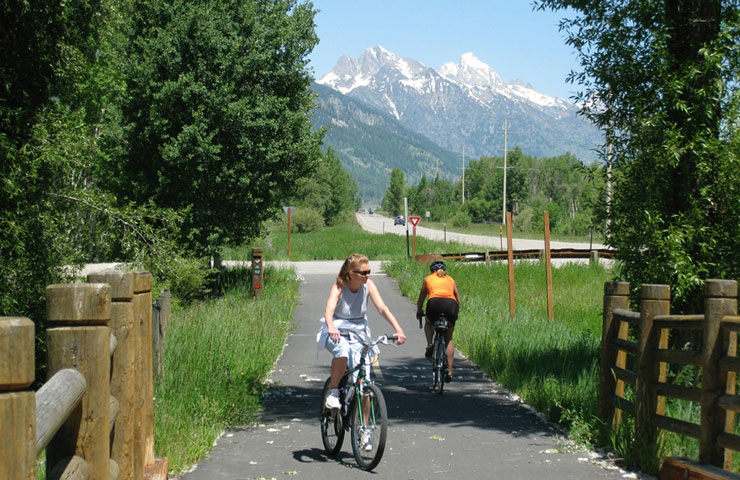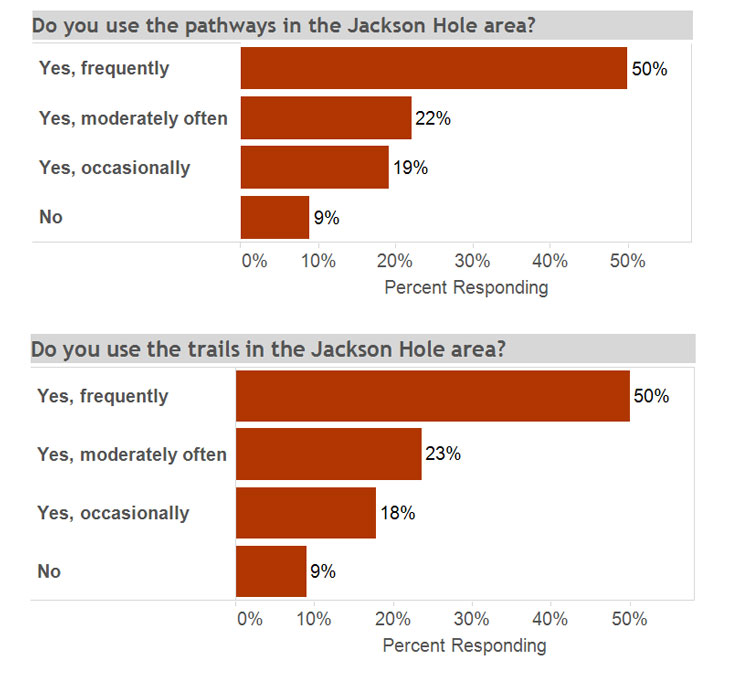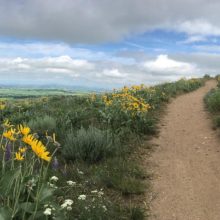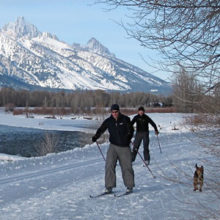- Nine out of 10 respondents use the pathways and trails in Teton County, Wyoming; with one in two doing so frequently.
- The survey results provide comprehensive information on pathways and trails usage, satisfaction, strengths, weaknesses, and suggestions for improvement to help community decision-makers, stakeholder groups, and interested citizens plan for the future of Jackson Hole’s pathways and trails systems.
- The strong use of trails and pathways demonstrates that public and private funds have been well-invested in creating, maintaining and completing the community’s trails and pathways.

The survey results are part of ongoing research by Headwaters Economics to provide comprehensive information on pathways and trails to help community leaders, elected officials, trail users, and others better understand the benefits of trails.
The survey, released today, was prepared for the Town of Jackson, Teton County, the Jackson Hole Chamber of Commerce, and Friends of Pathways and directed by Headwaters Economics and RRC Associates.
Survey Details
Undertaken in late 2014 and early 2015, the survey was conducted using three proven sampling methods: 1) a mail-back survey, 2) an online, invitation-only web survey to further encourage response from those residents already within the defined invitation sample, and 3) an open-link online survey for members of the public who were not part of the invitation sample.
A total of 2,500 surveys were mailed to a random sample of Teton County residents in November 2014 with the option of returning an enclosed hard copy of the survey or responding online. The final sample size was 1,179 (389 from the invitation survey and 790 from the open link survey), resulting in a margin of error of approximately +/- 2.9 percentage points calculated for questions at 50 percent response.
Survey Results
The full survey results are presented as a full report along with a summary report. Topline results are presented below.
Use of Pathways and Trails
Reported general usage patterns of pathways and trails were nearly identical, indicating the frequency of use of both systems are highly similar. Nine out of 10 respondents use the pathways and trails, with one in two doing so frequently. Only nine percent of respondents noted they do not use pathways or trails at all.

Average Use of Pathways per Month
Respondents estimated the days per month, on average, they personally use the pathways in the Jackson Hole area, both during summer (May through October) and winter (November through April). Overall, respondents use pathways roughly every other day in summer and every three days in winter. Average monthly pathways use is 16.1 total average days per month in summer and 11.8 days in winter. In summer, bicycling is the most popular activity (10.9 days on average per month). Walking comes in a close second, with 10.7 average days per month in summer. Walking is the most common activity in winter, at 8.6 average days per month. Skiing is the second most popular winter activity (3.6 days).
Average Use of Trails per Month
Respondents also estimated the days per month, on average, they personally use the trails in the Jackson Hole area, both during summer and winter. Overall, respondents use trails nearly every other day in summer and every three days in winter. Average monthly trail use is 13.6 total average days per month in summer and 9.7 days in winter. In summer, walking is the most popular activity (8.3 days on average per month), followed by bicycling (5.5 days). In winter, skiing is the most popular trail use (5.3 days), followed by walking (4.3 days).
Share of Use
When both pathways and trails systems were compared according to use, respondents indicated that pathways are important for both transportation and recreational purposes, while trails use is overwhelmingly recreational. Respondents who used each system at least occasionally were asked to indicate what percentage of their overall use was delegated toward certain purposes. One in two respondents use pathways for recreation, one in four use the pathways for commuting and getting to and from places, and one in five use the pathways for walking dogs and for family outings. Meanwhile, roughly three in four use the trails for recreation and one in five use the trails for walking dogs and family outings. Just 2 percent of overall trail use is for commuting to work/getting to and from places (compared to 23 percent of pathways use).
Satisfaction with Pathways and Trails
Respondents indicated their level of satisfaction with the maintenance and use of pathways and trails on a scale of 1 to 5, with 1 meaning “not at all satisfied,” and 5 meaning “extremely satisfied”. Summer maintenance of pathways and trails received high marks from residents (89 percent of respondents providing a rating of “4” or “5” for summer maintenance of pathways and 90 percent for summer maintenance of trails). Meanwhile, winter maintenance of pathways and trails were identified as priorities for improvement (just 61 percent of respondents provided a rating of “4” or “5” for both pathways and trails).
Importance of Trail Improvements
Respondents rated the level of importance of various potential trail improvements on a scale of 1 to 5, with 1 meaning “not at all important”, and 5 meaning “extremely important”. More loop trails was identified as most important (56 percent of respondents providing a rating of “4” or “5”). The next most important is separate user group experiences (51 percent wanting separate dog-walking, bicycling, hiking, and equestrian trails) followed by enhanced signage (45 percent). The remaining three potential improvement areas had a higher share of respondents indicating they were unimportant than important: enhanced trailhead facilities, more difficult trails, and more easy trails.
Factors That Would Encourage More Frequent Walking or Biking
Respondents reported up to three factors that would encourage them to walk or bike to work more frequently from a list of nine options. The most identified factor, noted by just over a third of all respondents, was “improve the network of pathways to get me where I want to go” (34 percent). A second tier of response included: living closer to work, more on-street bike lanes, and better integration with bikes and the START bus system. A shower/dressing room at work, a free ride home in an emergency or if plans changed, and more bike racks/bike storage options at place of work did not play as big a role in factors that would encourage walking or biking to work more frequently. Twenty-three percent of respondents reported that no factor would encourage them to walk or bike to work more frequently.
Important Factors in Decision to Move to or Stay in Teton County
Respondents rated the importance of various factors in their decision to move to or stay in Teton County using a scale of 1 to 5, with 1 meaning “not at all important” and 5 meaning “extremely important”. The responses indicated that outdoor recreation played the most important role, with nearly all respondents providing a rating of “4” or “5=extremely important”. Access to public land came in second (91%), closely followed by community character (89%), amount of open space (85%), and safe, secure community (85%).
Allocation of Funding Toward Pathways and Trails
If given $100 to spend across several different potential pathways and trails improvements, respondents would give the most toward building new pathways/completing missing links in the existing system ($38 allocated, on average). The next most identified funding priority was maintaining existing pathways ($28), followed by better/safer intersections ($10).
The LOR Foundation, whose goal is to enhance livability in the Intermountain West, provided funding for this research to help communities better understand the potential local impacts of trails and to make informed choices about investing in this infrastructure.




